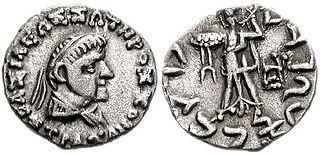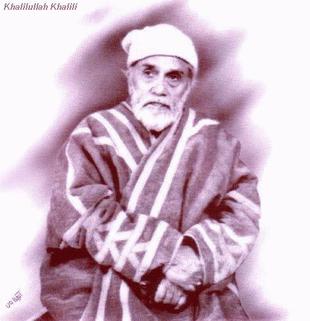Related Research Articles

Chandragupta II, also known by his title Vikramaditya, as well as Chandragupta Vikramaditya, was the third ruler of the Gupta Empire in India, and was one of the most powerful emperors of the Indian history.

Strato IISoter also known as Stratha, was an Indo-Greek king. He ruled c. 25 BCE to 10 CE according to Bopearachchi. R. C. Senior suggests that his reign ended perhaps a decade earlier. He may have been supplanted by the Indo-Scythian Northern Satraps, particularly Rajuvula and Bhadayasa, whose coins were often copied on those of the last Indo-Greek kings. Numerous coins of Rajuvula have been found in company with the coins of the Strato group in the Eastern Punjab and also in the Mathura area: for example, 96 coins of Strato II were found in Mathura in conjunction with coins of Rajuvula, who also imitated the designs of Strato II in the majority of his issues.

The Bimaran casket or Bimaran reliquary is a small gold reliquary for Buddhist relics that was removed from inside the stupa no.2 at Bimaran, near Jalalabad in eastern Afghanistan.

Elymais or Elamais was an autonomous state of the 2nd century BC to the early 3rd century AD, frequently a vassal under Parthian control. It was located at the head of the Persian Gulf in Susiana. Most of the population probably descended from the ancient Elamites, who once had control of that area.

Ibrahim I was the 33rd Shirvanshah. Because of his cunning politics he managed to remain independent and avoid being deposed by the Turko-Mongol ruler Timur.

Khalilullah I, also known as Sultan-Khalil (سلطان-خلیل), was the Shirvanshah from 1418 to 1465. He was the son and successor of Ibrahim I. He was succeeded by his son Farrukh Yasar.

Khalilullah Khalili was Afghanistan's foremost 20th century poet as well as a noted historian, university professor, diplomat and royal confidant. He was the last of the great classical Persian poets and among the first to introduce modern Persian poetry and Nimai style to Afghanistan. He had also expertise in Khorasani style and was a follower of Farrukhi Sistani. Almost alone among Afghanistan's poets, he enjoyed a following in Iran where his selected poems have been published. His works have been praised by renowned Iranian literary figures and intellectuals. Many see him as the greatest contemporary poet of the Persian language in Afghanistan. He is also known for his major work "Hero of Khorasan", a controversial biography of Habībullāh Kalakānī, Emir of Afghanistan in 1929.

Shirvanshah was the title of the rulers of Shirvan from 861 to 1538. The first ruling line were the Yazidids, an originally Arab and later Persianized dynasty, who became known as the Kasranids. The second ruling line were the Darbandi, distant relatives of the Yazidids/Kasranids.

Shāh Nimatullāh or Shāh Ni'matullāh Wali,, also spelled as Ne'matollah and Ni'matallah was the spiritual leader or Qutb of the Ni'matullah Order in Iran from the 14th and 15th centuries. He is revered by Sunni Islam as a saint and by the Ni'matullāhī tariqa, who consider him their founder.

Battle of Samugarh, Jang-e-Samugarh,, was a decisive battle in the struggle for the throne during the Mughal war of succession (1658–1659) between the sons of Mughal Emperor Shah Jahan after the emperor's serious illness in September 1657. The battle of Samugarh was fought between Dara Shikoh and his three younger brothers Aurangzeb, Shah Shuja and Murad Baksh to decide who would be the heir of the throne after their father.

Alexander Vladimirovich Bykov is a Russian historian and ethnographer, one of the leading Russian specialists in numismatics. Publisher, founder of the first Russian private museum of political history, the Museum of Diplomatic Corps in Vologda, Russia; he is the author of multiple articles, books, and popular science publications.

Fariburz ibn Sallar, better simply known as Fariburz I (فریبرز), was the sixteenth Shah of Shirvan, ruling from 1063 to 1096. His reign saw many major political balance changes in Caucasus, including expansion by the Seljuqs. He was considered a ruler with great diplomatic skills, and his kingdom extended from Mughan to Kumuk and Alania.
Afridun the Martyr was the eighteenth Shah of Shirvan. He was appointed governor of Derbent several times during his father's reign.
Mammad Hasan agha Sarijali Javanshir was a military leader and major-general of the Russian army, son and heir of Ibrahimkhalil khan of Karabakh, father of major-general, public figure and poet Jafargulu agha Javanshir also ancestor of famous Azerbaijani singer Khan Shushinski. He was born in 1766, Shusha as first son of Ibrahim Khalil Khan and his principal wife Khanum agha from Jabrayilli clan.

Dwitiyo Manob or Ditiyo Manob is a Bengali science fiction written by Bangladeshi writer Humayun Ahmed. This novel deals with the super natural powers of Homo superior and it is inspired by 1911 science fiction novel The Hampdenshire Wonder.
Khalilullah II was the 41st Shirvanshah, governing Shirvan under Safavid suzerainty between 1524—1535.
Burhan Ali was a self-declared Shah of Shirvan. He claimed to be son of Khalilullah II.
Seymur Baycan – an Azerbaijani writer, publicist, columnist.
Azerbaijan in antiquity covers the history of the territory of today's Azerbaijan in the period in which Greek and Roman society flourished and wielded great influence throughout much of Europe, North Africa, and Western Asia, as well as the Caucasus. The antique period in the territory of Azerbaijan was observed during the existence of Caucasian Albania in the north starting from the fourth century BC. This state emerged in this region after the death of the Alexander the Great and the collapse of his empire in the East in 323 BC.